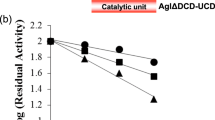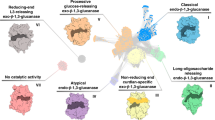Abstract
SINIGRIN is a crystalline thioglucoside, extracted first by Bussy1 from the seeds of black mustard. It is the potassium salt of the anion [C10H16O9NS2]−, also called the myronate ion, and the crystals contain one molecule of water per potassium ion. In 1897 Gadamer2 proposed formula (I) for the myronate ion. Schneider and collaborators confirmed the thioglycoside linkage in 1914 (ref. 3) and in 1930 (ref. 4) established that sinigrin and analogous glucosides are 1-β-D-thio-glucosides. Important details of the Gadamer formula I were challenged recently by Ettlinger and Lundeen5, who have advanced convincing arguments in favour of structure II, with the sugar in the β-gluco-pyranoside form. While Schultz and Wagner6 cast some doubt on II, on the basis of infra-red work, the synthesis by Ettlinger and Lundeen7 of the closely related glucotropaeolate ion (allyl replaced by benzyl) strongly affirmed the correctness of II. Ettlinger and Lundeen advanced arguments based on reaction mechanisms that suggest a syn configuration of sulphate and thioglucose relative to the C=N double bond. However, these arguments were inconclusive8,9. The chemistry of sinigrin and related compounds as well as their biological properties have been reviewed recently10. 
This is a preview of subscription content, access via your institution
Access options
Subscribe to this journal
Receive 51 print issues and online access
$199.00 per year
only $3.90 per issue
Buy this article
- Purchase on Springer Link
- Instant access to full article PDF
Prices may be subject to local taxes which are calculated during checkout
Similar content being viewed by others
References
Bussy, A., J. Pharmac. Chim., 26, 39 (1840).
Gadamer, J., Archiv der Pharmazie, 235, 44 (1897); Ber. deutsch. chem. Ges., 30, 2322 (1897).
Schneider, W., and Wrede, F., Ber. deutsch. chem. Ges., 47, 2225 (1914).
Schneider, W., Fischer, H., and Specht, W., Ber. deutsch. chem. Ges., 63, 2787 (1930).
Ettlinger, M. G., and Lundeen, A. J., J. Amer. Chem. Soc., 78, 4172 (1956).
Schultz, O. E., and Wagner, W., Arzneimittel-Forsch., 6, 647 (1956).
Ettlinger, M. G., and Lundeen, A. J., J. Amer. Chem. Soc., 79, 1764 (1957).
Lundeen, A. J., Ph.D. thesis, Rice Institute (1957).
Ettlinger, M. G., Dateo, jun., G. P., Harrison, B. W., Mabry, T. J., and Thompson, C. P., Proc. U.S. Nat. Acad. Sci., 47, 1875 (1961).
Kjaer, A., in Fortschritte der Chemie Organischer Naturstoffe, edit. by Zechmeister, L., 18, 122 (Springer, Wien, 1960); in Organic Sulphur Compounds, edit. by Kharash, N., 1, 413 (Pergamon Press, Oxford and New York, 1961).
Waser, J., Acta Cryst. (in the press).
Author information
Authors and Affiliations
Rights and permissions
About this article
Cite this article
WASER, J., WATSON, W. Crystal Structure of Sinigrin. Nature 198, 1297–1298 (1963). https://doi.org/10.1038/1981297b0
Issue Date:
DOI: https://doi.org/10.1038/1981297b0
Comments
By submitting a comment you agree to abide by our Terms and Community Guidelines. If you find something abusive or that does not comply with our terms or guidelines please flag it as inappropriate.



